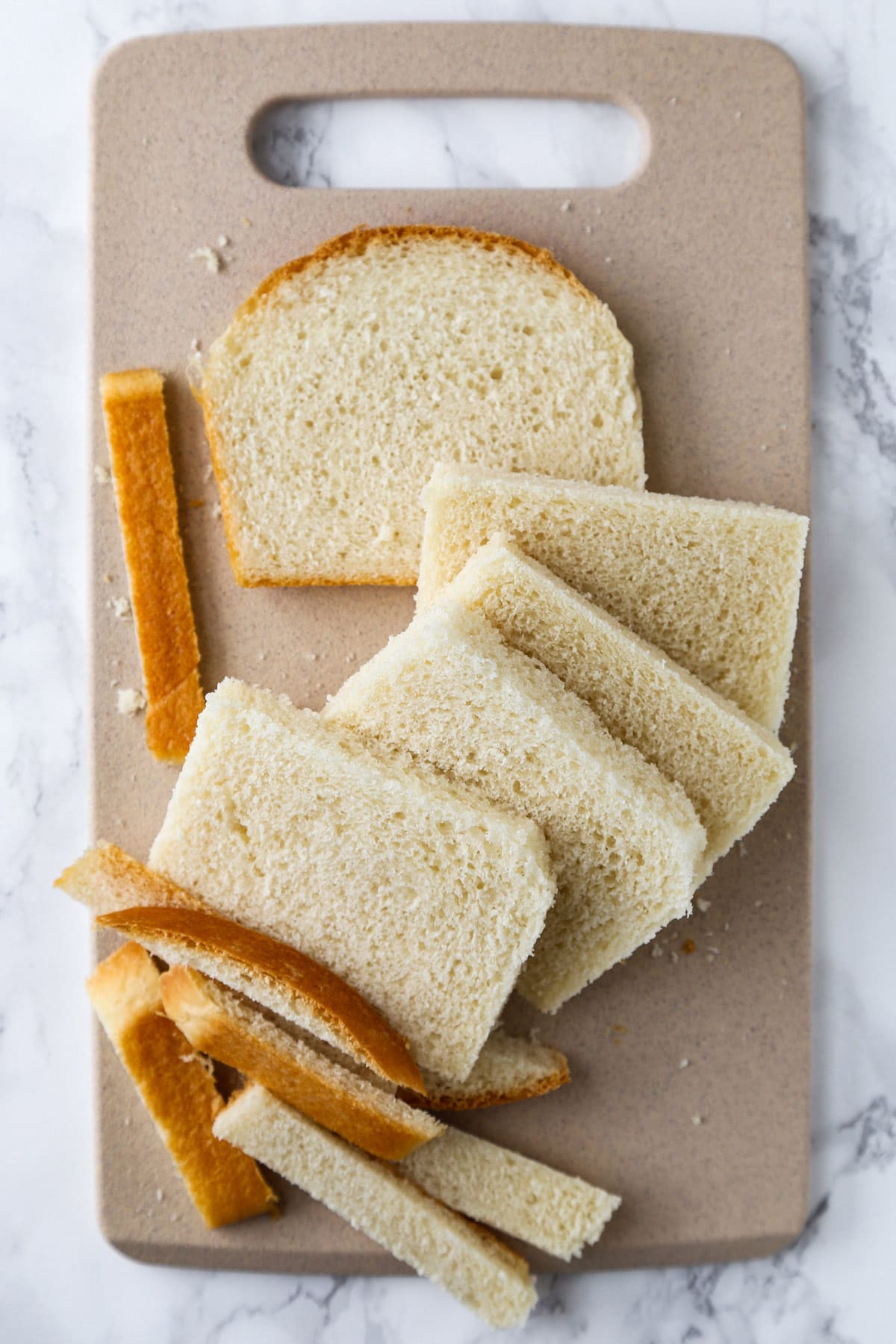Japanese egg sandwich is a creamy, tangy, light, and tasty snack that’s extremely popular all across Japan. Anthony Bourdain praised the deliciousness of Lawson’s egg salad sandwich, while David Chang runs to the closest konbini to get his hands on a tamago sando, as soon as he lands in Tokyo. The good news is you don’t have to travel across the world to get a taste of this iconic Japanese creation – I have an easy recipe you can make at home!

About this recipe
Japanese egg sandwich, called tamago sando (たまごサンド), is a no-frills egg salad sandwich made with Japanese milk bread, butter, and egg salad. What makes tamago sando different from the American version is that the components never change and doesn’t come with a slice of lettuce or tomato. The egg salad itself also tastes different because Japanese kewpie mayonnaise, which has a unique fruity and eggy taste, is used instead of regular mayonnaise.
In Japan, Japanese egg salad sandwiches can be found pretty much everywhere! The most common places are bakeries, coffee shops, and convenience stores (called konbini in Japanese) such as 7 Eleven, Lawson, or Family Mart. This is a very simple and basic recipe for this popular Japanese snack.
Table of contents

Ingredients Needed
- Japanese milk bread: You can find Japanese milk bread (shokupan – 食パン) in Japanese grocery stores and Japanese and Korean bakeries. Or you can make it from scratch by following my shokupan recipe here.
- Butter: The butter makes the sandwich more moist and creamy and is therefore essential to the recipe. You can use salted or unsalted.
- Eggs: Hard boiled eggs are best for this recipe. The quality of the eggs used can make a pretty significant difference on how the egg salad tastes. I would recommend spending a little extra money on pasture raised eggs such as the Vital Farms brand (which is what I use for just about everything) because they taste so much better. I get mine at Whole Foods.
- Japanese mayonnaise: You need Kewpie Mayo to make this sandwich. You can buy Kewpie Mayo in Japanese grocery stores, order it on Amazon, or make it from scratch using my recipe here.
- Salt: I’m using kosher salt but Himalayan pink salt also works. If you are using table salt, use a little less since the grains are smaller than kosher salt.
- Mustard: Yellow mustard makes the flavor pop a little more. Dijon mustard can also be used.
- Ground black pepper: A pinch or you can omit entirely. I’ll leave that one up to you.
Recipe Variations
- Add 1 to 2 teaspoons of milk or cream for a creamier texture.
- Add 1/4 teaspoon of granulated sugar to add a little sweetness.

How to Make Japanese Egg Sandwich
- Gather all of your kitchen tools and ingredients.
- Place the eggs in a bowl and use a fork to mash them.
- Stir in the mayonnaise, mustard, salt, and pepper, and continue mashing until the bits of eggs are all about the same size.
- Slice your bread and spread butter on all four slices.
- Spread egg salad on 2 slices and top with the other 2 slices of bread.
- Cut each sandwich in half and serve.
Expert Cooking Tip
Eggs must be hard boiled: While I generally do prefer my eggs to be poached or medium boiled, this is one instance when using hard boiled eggs yields better results. That’s because using soft eggs make the mixture watery and difficult to spread onto slices of bread. Always use hard boiled eggs when making egg sandwich for the best texture.
Do not over mash the eggs: Over mashing the eggs makes the texture less fluffy and pâté-like. I find that leaving little bits of egg white and egg yolk whole make the chewing experience more enjoyable.

Storage
To eat later: If you are not planning on eating the sandwich right way, keep the egg salad and bread separate. Save the egg salad in a storage container and refrigerate for up to 3 days.
Leftovers: Wrap the sandwiches in plastic wrap or save them in a storage container with a lid. They will keep for about 24 hours. After that the bread might be too soggy to enjoy.
Frequently Asked Questions
Challah bread or or supermarket white bread. Between the two I would recommend challah bread first because it’s fluffier and thicker. But supermarket white bread also works – you just won’t get the thicker slices.
No, obviously you can make this sandwich however you like! But if you want the traditional Japanese way, the crust must be removed.
I don’t recommend using medium boiled eggs if you are planning to mash them into an egg salad. This will make the texture very runny. Medium boiled eggs can be used if they are sliced in half and added to the sandwiches that way (with the mayonnaise and other ingredients spread onto the bread slices).

What To Serve With A Japanese Egg Salad Sandwich
Tamago sando can be served for breakfast, lunch, or as a snack. It’s high in protein and filling enough when served with a side dish. Some of my favorites are:
- Iceberg salad with carrot ginger dressing
- Miso soup
- Air fryer french fries
- Furikake fries
- Gomae (Japanese spinach salad with sesame sauce)
- Ramen noodle coleslaw

A Word On Conbini Food (Japanese Convenience Store Food)
Japanese convenience stores, called konbini in Japan, are the best in the world. Anyone who has been to one will tell you that the quality of food served there is as good, if not better than some restaurants. It’s low maintenance food done extremely well and at a very reasonable price. What also makes konbini store food stand out is the wide range of healthy dishes available such as onigiri, yakimeshi (fried rice) zaru soba (chilled soba noodles), oden (boiled vegetables, eggs, and fishcakes, in dashi broth), green salad, boiled kabocha squash, steamed sweet potatoes (satsumaimo), and seaweed salad.
Konbini foods are part of the Japanese culture. They feed the industrious crowds and college students. They help busy and sometimes overwhelmed parents put comforting food on the table. They make it possible for minimum wage workers to eat healthy. And they are so much fun to visit!

Did you like this recipe? Are there changes you made that you would like to share? Share your tips and recommendations in the comments section below!
Print
Japanese Egg Sandwich (Tamago Sando)
- Prep Time: 10 minutes
- Cook Time: 0 minutes
- Total Time: 10 minutes
- Yield: 2 sandwiches 1x
- Category: Sandwiches
- Method: N/A
- Cuisine: Japanese
- Diet: Vegetarian
Description
Japanese egg sandwich is a creamy, tangy, light, and tasty snack that’s extremely popular all across Japan.
Ingredients
- 4 slices shokupan (Japanese milk bread, also called Hokkaido bread) – if you cannot find shokupan you can make it from scratch using this recipe
- Butter
- 4 hard boiled eggs, peeled
- 5 tablespoons kewpie mayonnaise – if you cannot find kewpie mayo you can make it from scratch using this recipe
- 1/2 teaspoon kosher salt (use a little less for table salt, since the grains are smaller)
- 1/2 teaspoon yellow mustard
- Ground black pepper
Instructions
- Mash the eggs: Put the hard boiled eggs in a bowl and mash with a fork.
- Add the seasonings: Add the mayonnaise, mustard, salt and pepper, and stir. Continue mashing until the bits of egg are all about the same size (the smaller the better).
- Make the sandwich: Butter each slice of bread and spread the egg salad on two slices.
- Serve: Top with the other slice and cut the sandwich in half.
Notes
Storing egg salad: Put the egg salad in an airtight storage container and refrigerate for up to 5 days.
Nutrition
- Serving Size: 1 sandwich
- Calories: 596
- Sugar: 4.6g
- Sodium: 951.9mg
- Fat: 44.2g
- Saturated Fat: 11.3g
- Unsaturated Fat: 18g
- Trans Fat: 0.1g
- Carbohydrates: 30.1g
- Fiber: 1.6g
- Protein: 18.2g
- Cholesterol: 402.8mg















Fingers get very messy from the butter. But it’s still very good.
With the exception of the use of shokupan, this is exactly the recipe that my daughter and I developed a few weeks ago. We started using Kewpie Mayo about a year ago. Here in Hawaii, it’s readily available at Walmart. Anyway, we love these sandwiches. Next time I am at Don Quijote, Marukai, or at Ala Moana where they have two Brug Hokkaido bakeries, I’ll grab some shokupan to see if we can make it even better!
I’m so envious of you Frank! I love Don Quixote in Honolulu! ❤️
If you can get shokupan or make it, you will get the authentic taste. But a word to the wise. This surprised me the most! I went to my local grocery store and was glad to see that they were selling Kewpie mayonnaise. When I made my egg sando, there was something missing in the taste. Lo and behold, the Kewpie mayonnaise was made in USA not Japan! Tasting the mayo on it’s own, there was the culprit to may odd taste. Just an FYI, when you buy Kewpie mayo, make sure it’s made in Japan or follow Pickled Plum’s recipe.
Good point Margaret! I think American Kewpie mayo doesn’t contain any msg and that’s why it tastes so different. Thanks for sharing your tip, I will also make sure to double check where it’s from next time I buy it! 🙂
After you guys mentioned that the American Kewpie is different than the Japanese Kewpie, I took a look at what I had. Interestingly, the Kewpie I bought at Costco (little bottles shaped like the traditional Kewpie bottles but much firmer plastic) says that it’s made in America but the Kewpie I bought at Walmart (larger bottle made of thinner, floppier plastic) says “Product of Japan”. So, look around, different places might have different Kewpies!
I love to cook
But i really need to eat more healthy foods.
And i always have been drawn to Asian way of cooking or any meal cooked full of flavor and more vegetables.